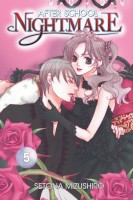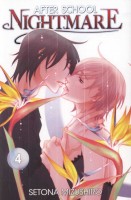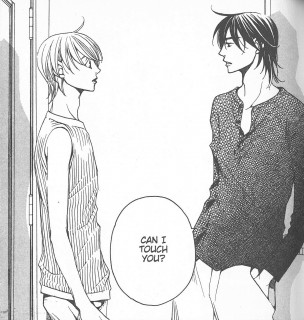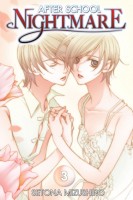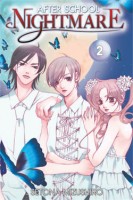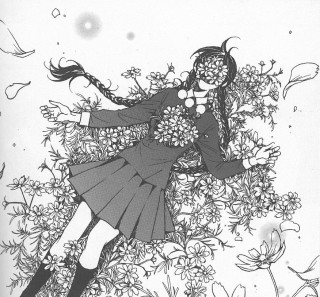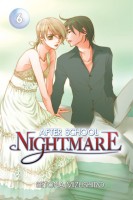 Creator: Setona Mizushiro
Creator: Setona Mizushiro
U.S. publisher: Go! Comi
ISBN: 9781933617480
Released: January 2008
Original release: 2006
The sixth volume of the manga series After School Nightmare, an intense and dark psychological drama by Setona Mizushiro, was originally published in Japan in 2006. The English-language edition of After School Nightmare, Volume 6 was released by Go! Comi in 2008. Go! Comi is no more, so the entire series has gone out-of-print, but the manga still seems to be relatively easy to find. After School Nightmare is a series that honestly disturbs me, which isn’t necessarily a bad thing since in part it’s a horror manga. But while I find After School Nightmare to be disconcerting, I also find it to be oddly compelling. Mizushiro deals with some heavy issues in the series, including emotional, psychological, and physical abuse, trauma, and violence. The search for personal identity and the roles that gender and sexuality play in defining who a person is are major themes as well. In fact, it was those themes that first drew After School Nightmare to my attention.
Despite some lingering doubts, Mashiro made the decision to give up on his feelings for Sou in favor of his feelings for Kureha. Sadly for him, things aren’t turning out how he would have liked at all. Tying his masculinity to her insecurities, Mashiro wanted to feel needed by Kureha, to become her white knight and protector. But now Kureha is beginning to feel more confident in herself and trying to rely less on Mashiro. Suddenly finding himself without an acceptable role to play in their relationship, and no longer being able to meet the established though self-imposed requirements of what it means to be a man, Mashiro is thrown into turmoil. In the past he presented himself as a prince who would rescue those who were weaker than him, but it’s help that is no longer wanted nor needed. Just when he thought that he had everything finally figured out, Mashiro finds his relationships falling apart because they were built on his own insecurities and fears. He is desperate to be seen as a man by others and at the same time is terrified by the fact that he also yearns to express his femininity.
 Most of After School Nightmare takes place in one of three settings: the school grounds, the dormitories associated with the school, and the shared nightmares of the students participating in the special after school class required for their graduation. Granted, it’s not graduation in the usual sense. The students who successfully complete the course completely disappear from the campus and from the memories of those left behind, almost as if they never existed at all. The mysteries surrounding what it really means to graduate combined with the story’s limited settings create a marvelously ominous and claustrophobic atmosphere. As a result, when the series breaks from that narrow focus, it can be especially unsettling. In the sixth volume, for what I believe is the first time in After School Nightmare, a truly significant scene occurs away from the school entirely, which serves to emphasize Mashiro’s reluctance to deal with his issues head on. But it’s a moment of false freedom; he won’t be able to run away from his problems indefinitely without there being negative consequences.
Most of After School Nightmare takes place in one of three settings: the school grounds, the dormitories associated with the school, and the shared nightmares of the students participating in the special after school class required for their graduation. Granted, it’s not graduation in the usual sense. The students who successfully complete the course completely disappear from the campus and from the memories of those left behind, almost as if they never existed at all. The mysteries surrounding what it really means to graduate combined with the story’s limited settings create a marvelously ominous and claustrophobic atmosphere. As a result, when the series breaks from that narrow focus, it can be especially unsettling. In the sixth volume, for what I believe is the first time in After School Nightmare, a truly significant scene occurs away from the school entirely, which serves to emphasize Mashiro’s reluctance to deal with his issues head on. But it’s a moment of false freedom; he won’t be able to run away from his problems indefinitely without there being negative consequences.
The nightmares in After School Nightmare are intended to be an environment in which the students can work through their personal traumas and fears, but the participants are simultaneously stripped of many of their defenses and left incredibly vulnerable within the dreams as well. In theory, what happens in the dreams is meant to remain private and not to carry over into the waking world, but in practice that is rarely ever the case. Even so, most of Mashiro’s growth and maturation is thanks to those nightmares. It’s not until After School Nightmare, Volume 6 that he’s forced to really begin to recognize outside of them how selfish and self-centered his relationships with other people have been, how he’s using them to make himself feel better about himself, and how his actions affect others. In many ways, Mashiro’s waking life is just as much of a fantasy as the dreams he is made to share with his classmates, and both reality and nightmares can be troubling and traumatic. However, it’s the nightmares that are the more truthful and honest even though they can also be highly symbolic and strange. In the end, as horrifying as the dreams are, the denial and insidious falsehoods of reality may ultimately be the more damaging.

